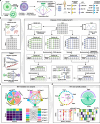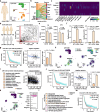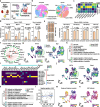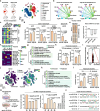Extracellular vesicle-derived miRNA-mediated cell-cell communication inference for single-cell transcriptomic data with miRTalk
- PMID: 40229908
- PMCID: PMC11998287
- DOI: 10.1186/s13059-025-03566-x
Extracellular vesicle-derived miRNA-mediated cell-cell communication inference for single-cell transcriptomic data with miRTalk
Abstract
MicroRNAs are released from cells in extracellular vesicles (EVs), representing an essential mode of cell-cell communication (CCC) via a regulatory effect on gene expression. Single-cell RNA-sequencing technologies have ushered in an era of elucidating CCC at single-cell resolution. Herein, we present miRTalk, a pioneering approach for inferring CCC mediated by EV-derived miRNA-target interactions (MiTIs). The benchmarking against simulated and real-world datasets demonstrates the superior performance of miRTalk, and the application to four disease scenarios reveals the in-depth MiTI-mediated CCC mechanisms. Collectively, miRTalk can infer EV-derived MiTI-mediated CCC with scRNA-seq data, providing new insights into the intercellular dynamics of biological processes.
Keywords: Cell–cell communication; Extracellular vesicle; MiRNA; ScRNA-seq; Spatial transcriptomics.
© 2025. The Author(s).
Conflict of interest statement
Declarations. Ethics approval and consent to participate: Not applicable. Consent for publication: Not applicable. Competing interests: The authors declare that they have no competing interests.
Figures








Similar articles
-
Deciphering cell-cell communication at single-cell resolution for spatial transcriptomics with subgraph-based graph attention network.Nat Commun. 2024 Aug 18;15(1):7101. doi: 10.1038/s41467-024-51329-2. Nat Commun. 2024. PMID: 39155292 Free PMC article.
-
Integrative analysis of miRNA in cartilage-derived extracellular vesicles and single-cell RNA-seq profiles in knee osteoarthritis.Arch Biochem Biophys. 2023 Oct 15;748:109785. doi: 10.1016/j.abb.2023.109785. Epub 2023 Oct 14. Arch Biochem Biophys. 2023. PMID: 37844826
-
Human Adult Astrocyte Extracellular Vesicle Transcriptomics Study Identifies Specific RNAs Which Are Preferentially Secreted as EV Luminal Cargo.Genes (Basel). 2023 Mar 31;14(4):853. doi: 10.3390/genes14040853. Genes (Basel). 2023. PMID: 37107614 Free PMC article.
-
Extracellular vesicle transfer of cancer pathogenic components.Cancer Sci. 2016 Apr;107(4):385-90. doi: 10.1111/cas.12896. Epub 2016 Mar 18. Cancer Sci. 2016. PMID: 26797692 Free PMC article. Review.
-
Exosomes provide unappreciated carrier effects that assist transfers of their miRNAs to targeted cells; I. They are 'The Elephant in the Room'.RNA Biol. 2021 Nov;18(11):2038-2053. doi: 10.1080/15476286.2021.1885189. Epub 2021 May 4. RNA Biol. 2021. PMID: 33944671 Free PMC article. Review.
References
-
- Makarova J, Turchinovich A, Shkurnikov M, Tonevitsky A. Extracellular miRNAs and cell-cell communication: problems and prospects. Trends Biochem Sci. 2021;46:640–51. - PubMed
-
- Wang J, Li L, Zhang Z, Zhang X, Zhu Y, Zhang C, Bi Y. Extracellular vesicles mediate the communication of adipose tissue with brain and promote cognitive impairment associated with insulin resistance. Cell Metab. 2022;34(1264–1279): e1268. - PubMed
MeSH terms
Substances
Grants and funding
- 82200725/National Natural Science Foundation of China
- 81930016/National Natural Science Foundation of China
- ZYYCXTD-D-202002/Innovation Team and Talents Cultivation Program of National Administration of Traditional Chinese Medicine
- 226-2023-00059/Fundamental Research Funds for the Central Universities
- 226-2023-00114/Fundamental Research Funds for the Central Universities
LinkOut - more resources
Full Text Sources

